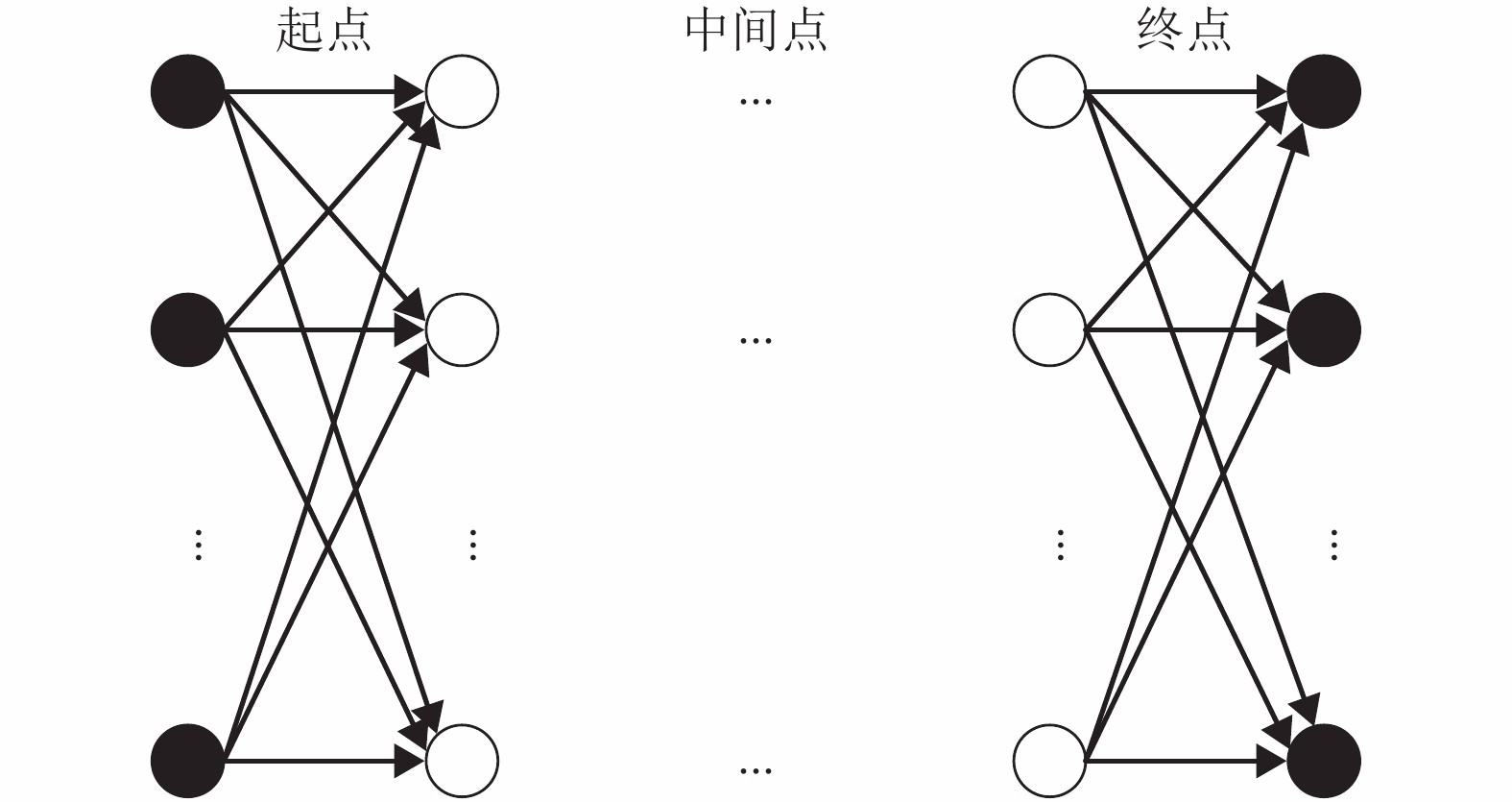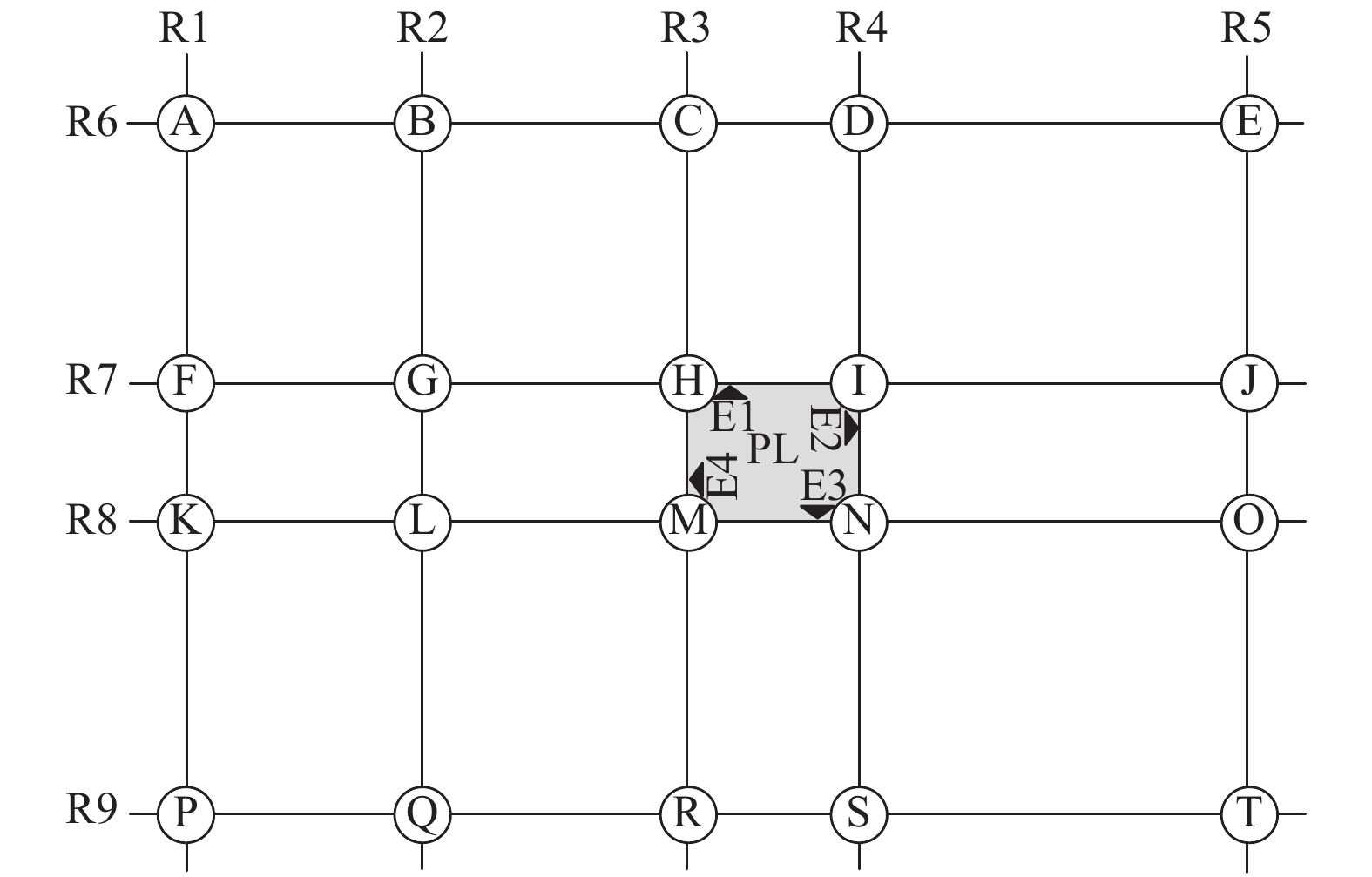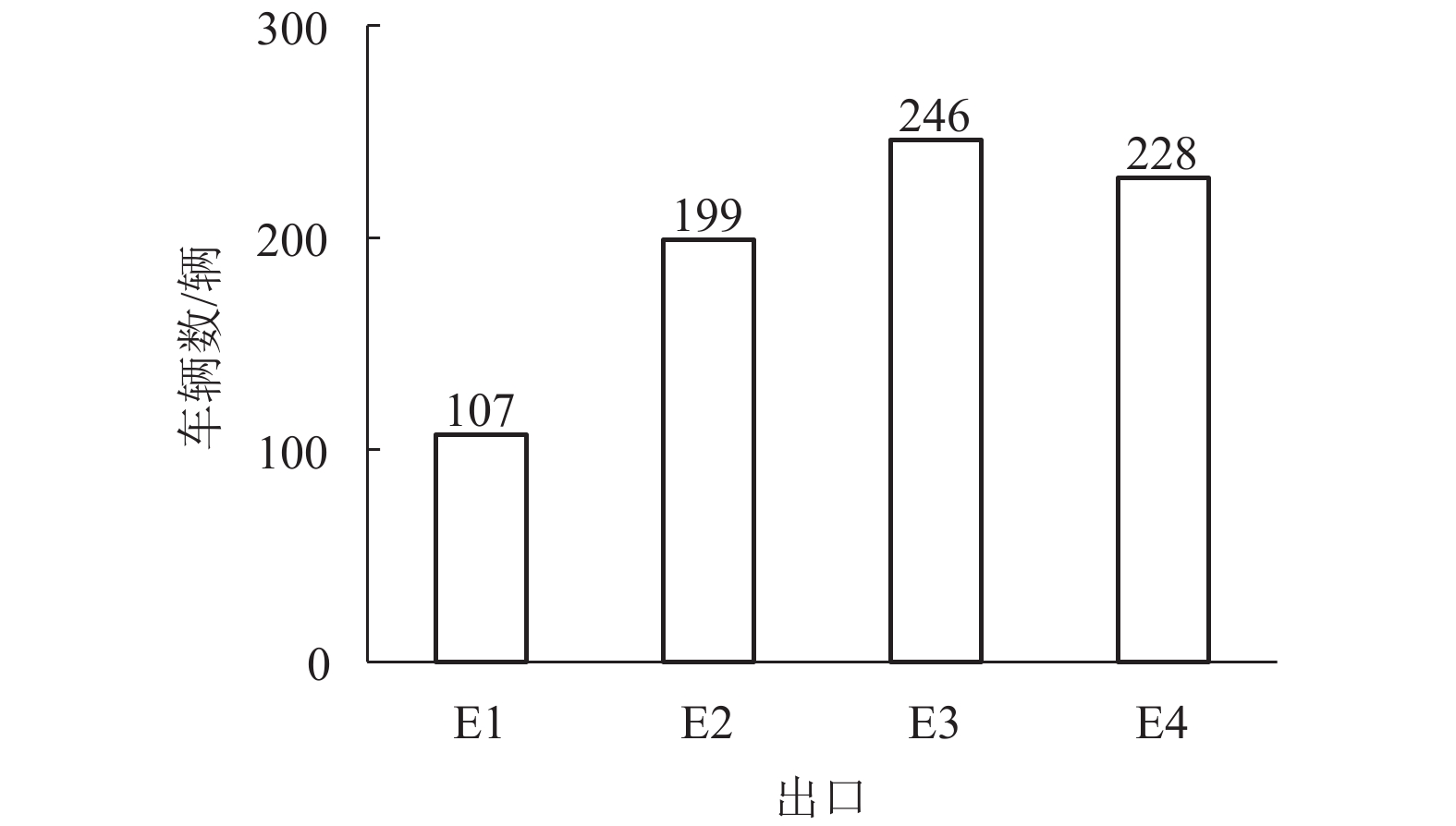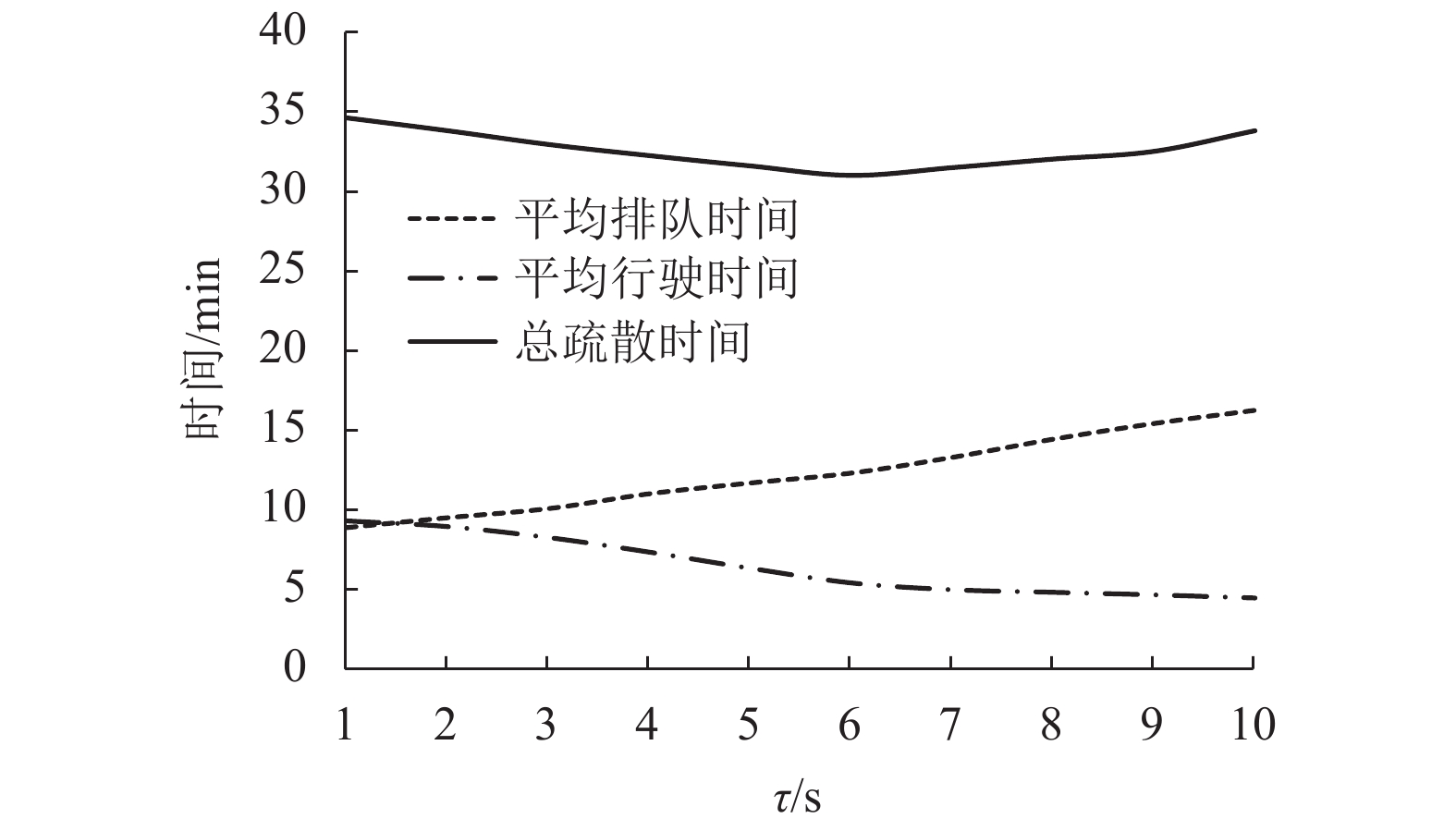Optimal Evacuation Model of Parking Vehicles in Dynamic Traffic Flows
-
摘要: 为有效地制定停车场车辆疏散方案,缩短车辆疏散时间,研究了考虑道路网动态交通流特征的停车场车辆最优疏散模型. 首先,根据排队论将停车场每个出口车道的车辆排队抽象成一个M/M/1/1排队系统,分析出口道路交通流车头时距对车辆离开率的影响,从而估算车辆在停车场内的排队时间. 其次,构建道路网节点交通流均衡模型和路段交通流均衡模型模拟车辆的疏散路径选择行为,并估算疏散车辆的行驶时间以及在交叉口的延误时间. 最后,选取一个具有4个出口的停车场进行车辆疏散仿真模拟. 研究结果表明:出口处道路交通流车头时距对停车场车辆排队时间、行驶时间和总疏散时间均有显著影响,并且车辆在道路网中最优路径的选择主要受非疏散交通流影响;该模型能模拟停车场车辆在疏散过程中的动态交通特征及时间消耗,根据出口处道路交通流车头时距动态调整车辆离开率,提升疏散效率.Abstract: In order to develop an effective evacuation plan for vehicles in a parking lot and achieve the shortest evacuation time, an optimal evacuation model was built by considering the dynamic traffic flow characteristics of a road network. Firstly, according to queuing theory, the vehicle queue on each exit lane of a parking lot was denoted by an M/M/1/1 queuing system, which was used to simulate how the traffic flow headway on the exit lane affects the vehicle departure rate, and estimate the queue time of the vehicles in the parking lot. Secondly, the traffic flow equilibrium model of road network nodes and link traffic flow equilibrium model were employed to imitate the path selection behavior in vehicle evacuation, and the evacuation time and delay time at intersections were estimated. Finally, a parking lot with 4 exits was selected to conduct an evacuation simulation. The results show that the traffic flow headway on the exit lane has a significant impact on vehicle queue time, travel time and evacuation time, while the optimal route choices are mainly affected by background traffic, demonstrating that the proposed model can simulate the dynamic traffic characteristics and time consumption during the evacuation process and adjust the departure rate to improve the evacuation efficiency according to the traffic flow headway.
-
Key words:
- transport engineering /
- evacuation model /
- dynamic traffic flow /
- parking lot /
- queuing theory
-
表 1 最优疏散路径
Table 1. Optimal evacuation routes
起点 终点 路径 路径编号 疏散车辆数/辆 E1 D E1—I—J R1 48 J E1—I—D R2 59 E2 S E2—N—S R3 107 O E2—N—O R4 92 E3 R E3—M—R R5 105 K E3—M—L—K R6 80 Q E3—M—L—Q R7 61 E4 C E4—H—C R8 84 B E4—H—G—B R9 93 F E4—H—G—F R10 51 -
张尧. 城市交通车流拥堵疏散路径优化识别研究[J]. 计算机仿真,2017,34(2): 200-203. doi: 10.3969/j.issn.1006-9348.2017.02.043ZHANG Yao. Study on optimization of uban traffic congestion evacuation route[J]. Computer Simulation, 2017, 34(2): 200-203. doi: 10.3969/j.issn.1006-9348.2017.02.043 洪玲,徐瑞华,段晓英. 基于动态切换的城市轨道交通车站应急疏散模型[J]. 同济大学学报(自然科学版),2016,44(1): 87-94.HONG Ling, XU Ruihua, DUAN Xiaoying. Emer-gency evacuation model of urban rail transit station based on dynamic switching pattern[J]. Journal of Tongji University (Natural Science), 2016, 44(1): 87-94. YUAN Y, LIU Y, YU J. Trade-off between signal and cross-elimination strategies during evacuation traffic management[J]. Transportation Research Part C:Emerging Technologies, 2018, 97(2): 385-408. COLLINS A J, ROBINSON R M, JPRDAN C A, et al. Development of a traffic incident model involving multiple municipalities for inclusion in large micro-scopic evacuation simulations[J]. International Journal of Disaster Risk Reduction, 2018, 31(10): 1223-1230. SHEFFI Y, MAHMASSANI H, POWELL W B. A transportation network evacuation model[J]. Transpor-tation Research Part A:General, 1982, 16(3): 209-218. doi: 10.1016/0191-2607(82)90022-X YAMADA T. A network flow approach to a city emergency evacuation planning[J]. International Journal of Systems Science, 1996, 27(10): 931-936. doi: 10.1080/00207729608929296 COVA T J, DENNISON P E, DREWS F A. Modeling evacuate versus shelter-in-place decisions in wild-fires[J]. Sustainability, 2011, 3(10): 1662-1687. doi: 10.3390/su3101662 FANG Z, ZONG X, LI Q, et al. Hierarchical multi-objective evacuation routing in stadium using ant colony optimization approach[J]. Journal of Transport Geography, 2011, 19(3): 443-451. doi: 10.1016/j.jtrangeo.2010.10.001 SBAYTI H, MAHMASSANI H S. Optimal scheduling of evacuation operations[J]. Transportation Research Record, 2006, 1964(1): 238-246. doi: 10.1177/0361198106196400126 BRETSCHNEIDER S, KIMMS A. A basic mathe-matical model for evacuation problems in urban areas[J]. Transportation Research Part A:Policy and Practice, 2011, 45(6): 523-539. doi: 10.1016/j.tra.2011.03.008 HSU Y-T, PEETA S. Clearance time estimation for incorporating evacuation risk in routing strategies for evacuation operations[J]. Networks and Spatial Economics, 2015, 15(3): 743-764. doi: 10.1007/s11067-013-9195-5 CHIU Y C, ZHENG H. Real-time mobilization decisions for multi-priority emergency response resources and evacuation groups:model formulation and solution[J]. Transportation Research Part E:Logistics and Transportation Review, 2007, 43(6): 710-736. doi: 10.1016/j.tre.2006.11.006 TAK S, KIM S, YEO H. Agent-based pedestrian cell transmission model for evacuation[J]. Transportmetrica A: Transport Science, 2018, 14(5/6): 484-502. MURRAY-TUITE P, WOLSHON B. Evacuation transportation modeling:an overview of research,development,and practice[J]. Transportation Research Part C: Emerging Technologies, 2013, 27(2): 25-45. WILLIAMS B M, TAGLIAFERRI A P, MEINHOLD S S, et al. Simulation and analysis of freeway lane reversal for coastal hurricane evacuation[J]. Journal of Urban Planning and Development, 2007, 133(1): 61-72. doi: 10.1061/(ASCE)0733-9488(2007)133:1(61) CHIEN S I, KORIKANTHIMATH V V. Analysis and modeling of simultaneous and staged emergency evacuations[J]. Journal of Transportation Engineering, 2007, 133(3): 190-197. doi: 10.1061/(ASCE)0733-947X(2007)133:3(190) SFEIR G, ANTONIOU C, ABBAS N. Simulation-based evacuation planning using state-of-the-art sensitivity analysis techniques[J]. Simulation Modelling Practice and Theory, 2018, 89(12): 160-174. AGUILAR L, WIJERATHNE L, JACOB S, et al. Mass evacuation simulation considering detailed models:behavioral profiles,environmental effects,and mixed-mode evacuation[J]. Asia Pacific Management Review, 2019, 24(2): 114-123. doi: 10.1016/j.apmrv.2019.05.001 BALAKRISHNA R, WEN Y, BEN-AKIVA M, et al. Simulation-based framework for transportation network management in emergencies[J]. Transportation Research Record, 2008, 2041: 80-88. doi: 10.3141/2041-09 LAMMEL G, CHRAIBI M, WAGOUM A U K, et al. Hybrid multimodal and intermodal transport simulation:case study on large-scale evacuation planning[J]. Transportation Research Record, 2016, 2561: 1-8. doi: 10.3141/2561-01 KIMMS A, MAASSEN K C. Optimization and simulation of traffic flows in the case of evacuating urban areas[J]. OR Spectrum, 2011, 33(3): 571-593. doi: 10.1007/s00291-011-0264-1 CHANG J, WANG J. Unreliable M/M/1/1 retrial queues with set-up time[J]. Quality Technology & Quantitative Management, 2018, 15(5): 589-601. IDJIS K, OURBIH-TARI M, BAGHDALI-OURBIH L. Variance reduction in M/M/1 retrial queues using refined descriptive sampling[J]. Communications in Statistics − Simulation and Computation, 2017, 46(6): 5002-5020. doi: 10.1080/03610918.2016.1140778 ZHOU M, LIU L, CHAI X, et al. Equilibrium strategies in a constant retrial queue with setup time and the N-policy[J]. Communications in Statistics − Theory and Methods, 2020, 49(7): 1695-1711. DI GANGI M, CANTARELLA G E, DI PACE R, et al. Network traffic control based on a mesoscopic dynamic flow model[J]. Transportation Research Part C: Emerging Technologies, 2016, 66(6): 3-26. LEVIN M W, BOYLES S D, DUTHIE J, et al. Demand profiling for dynamic traffic assignment by integrating departure time choice and trip distribution[J]. Computer-Aided Civil and Infrastructure Engineering, 2016, 31(2): 86-99. doi: 10.1111/mice.12140 WANG J, MAO X, LI Z, et al. Determining the reasonable scale of a toll highway network in China[J]. Journal of Transportation Engineering, 2014, 140(10): 1-11. LEE S, WONG S. Group-based approach to predictive delay model based on incremental queue accumulations for adaptive traffic control systems[J]. Transportation Research Part B: Methodological, 2017, 98(4): 1-20. SAIDI-MEHRABAD M, DEHNAVI-ARANI S, EVAZABADIAN F, et al. An ant colony algorithm (ACA) for solving the new integrated model of job shop scheduling and conflict-free routing of AGVs[J]. Computers & Industrial Engineering, 2015, 86(8): 2-13. LIU J, YANG J, LIU H, et al. An improved ant colony algorithm for robot path planning[J]. Soft Computing, 2017, 21(19): 5829-5839. doi: 10.1007/s00500-016-2161-7 -






 下载:
下载:





